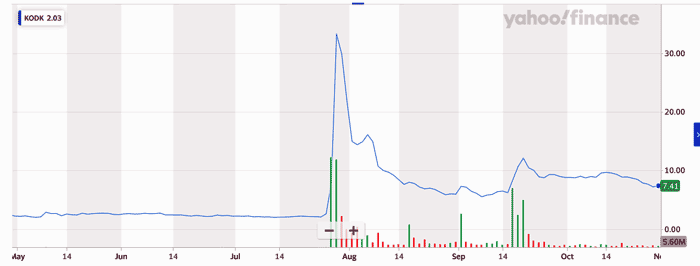While the internal report commissioned by Eastman Kodak Company, Regarding the events surrounding the US International Development Finance Corporation Letter of Interest, exonerates everyone involved, the company it describes is not one to which any responsible government would loan a billion dollars.
‘Kodak is committed to the highest levels of governance and transparency, and it is clear from the review’s findings that we need to take action to strengthen our practices, policies, and procedures,’ said CEO Jim Continenza. ‘Expeditiously implementing these recommended measures will be critical as we continue to execute on our long-term strategy and transform our business for the future.’
In the report by law firm Akin Gump into five separate potential insider trading issues, all executives are cleared of wrong-doing, although the Eastman Kodak legal department head, Roger Byrd, might be feeling a bit battered and bruised by its assessment of his performance. And the ‘relatively junior’ but unnamed PR department employee who sent out a media advisory a day early is no doubt happy to remain unnamed.

First some background: Prompted by the Covid pandemic and the US Government’s realisation that the country was heavily reliant on China for supply of essential medicines, Eastman Kodak, with CEO Jim Continenza to the fore, started working towards playing a role manufacturing precursor chemicals for the US pharmaceutical industry. ‘Among other things, Kodak was interested in the possibility of obtaining a government grant or loan that could be used to finance the repurposing of its facilities for this type of chemical manufacturing,’ the report explains. This initiative began in March.
By April, Eastman Kodak had managed to attract the interest of Peter Navarro, Director of the White House Office of Trade and Manufacturing Policy. On May 14, President Trump authorised the Development Finance Corporation (DFC) to provide loans to support the ‘domestic production of strategic resources needed to respond to the COVID-19 outbreak, or to strengthen any relevant domestic supply chains.’
After much to-ing and fro-ing between Eastman Kodak and the DFC in the following weeks, a Letter of Interest (LOI) for a US$765 million loan was agreed on June 22 and announced – first prematurely by Eastman Kodak on July 27, and then officially on July 28. Not long after, all hell broke lose as Democrat-fuelled accusations of insider trading at Eastman Kodak, in particular by CEO Jim Continenza, hit the press. The offer of the loans was withdrawn pending the results of an SEC enquiry – which is yet to be released.
The report from Akin Gump to a special committee set up by the Eastman Kodak Board of Directors looked at five specific issues. These were:
1. Whether Board member Philippe Katz or Executive Chairman and CEO Jim Continenza engaged in insider trading, violated Kodak’s internal policies and procedures, or otherwise acted improperly in purchasing Kodak shares in June 2020.
CEO Jim Continenza purchased 46,737 shares at $2.22 on the final day permissable, June 23. Katz made A MUCH SMALLER PURCHASE. Akin Gump found that both board members sought and obtained ‘preclearance to trade’ from Kodak’s General Counsel, Roger Byrd, in compliance with the Company’s insider trading policies. The report isn’t so unequivocal regarding whether that preclearance to trade should have been permitted by Roger Bryd, only that is was made in good faith.
The report is relentless in emphasising the perception within Eastman Kodak that first, any support from the US Government was unlikely, and that even if it was secured, any rise in the share price wasn’t guaranteed. Therefore, no insider trading: ‘Byrd analyzed whether Continenza possessed MNPI (‘material non-public information’) concerning the DFC application process.’ Byrd concluded that Continenza did not have insider information ‘because the outcome of the DFC application was uncertain, and even if Kodak ultimately received a loan, it was uncertain what impact the news of Kodak taking on such a large amount of debt would have on the stock price.’
It’s extraordinary that four weeks prior to their success in securing the $1 billion loan, there was, according to this report, such negativity and pessimism among members of the Eastman Kodak project team working towards it, including the CEO and General Counsel. (Although that didn’t stop Continenza from purchasing that $100,000 worth of Kodak shares.)
2. Whether Kodak’s award of stock options to Continenza and other members of Kodak’s senior management team on July 27, 2020, the day prior to the DFC Announcement, violated Kodak’s internal policies and procedures or the federal securities laws or constituted a breach of fiduciary duty under applicable state law.

Akin Gump concludes no, no and no. On July 27, the date the LOI announcement was made public, Continenza was awarded 1,750,000 options. The majority of these had a strike price (a price at which their value can be realised, as opposed to being simply options) of just $3.03 – within coo-ee of the then current share price. Akin Gump says the July 27, 2020 options grants complied with Kodak’s internal rules, and had been up for discussion prior to the start of the DFC application process. It concedes that while granting stock options to Board members immediately before positive news can be controversial, ‘it is not prohibited by SEC regulations and can only give rise to state law breach of fiduciary duty claims under certain circumstances not present here.’
Once again, General Counsel gets a little touch up: ‘We did identify several flaws in the process that Kodak’s General Counsel followed with respect to the grants. As a result, Kodak’s Board and the CNG Committee were not warned that the timing of the grants could give rise to concerns about so-called options “spring loading,” regardless of whether these particular options grants were ultimately determined to be legal.’ (‘Spring-loading’ is when the options immediately reach their strike price because the stock price rises rapidly after positive news – like, say, a partnership with the US Government.
Options were also awarded to other executives as well, including Byrd.
3. Whether Board member George Karfunkel violated the federal securities laws or Kodak’s internal policies and procedures by donating 3 million Kodak shares to an affiliated charity the day after the DFC Announcement, while the Company’s trading window remained closed (ie, during a period where the Company’s policies prohibited purchases or sales of its securities by designated insiders and Board members, which included Karfunkel).
Akin Gump concluded: ‘It does not appear that his charitable gift of Kodak shares the day after the DFC Announcement violated the federal securities laws’ and ‘Kodak’s policies and procedures did not clearly prohibit Karfunkel from making the gift, even though it occurred during a closed trading window.’
Karfunkle established the Congregation Chemdas Yisroel Inc religious charity several years ago. It operates a Jewish Orthodox school in Brooklyn, according to Karfunkel, who as well as being the founder of the charity, appears to be its driving force and key executive.
To casual observers such as this writer, the Karfunkel gift was perhaps the most startling move of them all. It appears Akin Gump was precluded from exploring the tax advantages this delivered: Karfunkel donated his 3 million shares on July 29, when the share price opened at $18, hit $60 and closed at $33. If the shares were sold at $33, that’s effectively a $US$99 million tax deductible donation, which would deliver the donator a tax benefit worth tens of millions of dollars.
‘Akin Gump’s ability to fully investigate the bona fides of the gift or the charity that received it was limited because we did not have access to the records of the charity and were unable to interview any of its officers or directors, with the exception of Karfunkel. The potential tax implications of Karfunkel’s gift are outside of the scope of Akin Gump’s investigation.’
Here again, Akin Gump points the finger at General Council: ‘Byrd never indicated that Karfunkel needed to obtain pre-approval to make a gift of Kodak shares under the Company’s policies and did not realize at the time that there was language in the written policies that suggested this was required.’
4.Whether Kodak was responsible for the early release of information related to the LOI on July 27, 2020, the day before the DFC Announcement, and, if so, whether that release violated Regulation Fair Disclosure (“Reg FD”), promulgated by the U.S. Securities and Exchange Commission (“SEC”).
Akin Gump concedes that Eastman Kodak sent out a media advisory on July 27 pre-announcing the LOI, and as a result two news outlets, on the day before the scheduled announcement, tweeted information about Kodak working with the government.
This error was made because a relatively junior employee in the PR department apparently sent it out without an embargo notice, but rather with ‘language indicating that it was for immediate release.’ (That is, it was marked ‘For Immediate Release’!)
‘While this early release of information was not in accordance with best practices, it did not violate Reg FD.’ Nonetheless the share price rose by over 20 percent on the day this slip-up was made.
5. Whether Moses Marx, the father-in-law of Board member Katz, or Southeastern Asset Management (“Southeastern”), a large Kodak investor that had nominated two of Kodak’s Board members, sold shares of Kodak after the DFC Announcement while in possession of material nonpublic information (“MNPI”) obtained from any of Kodak’s officers, directors, or employees.
Yeah nuh. The report states that Marx sold 250,303 shares on July 29, 2020 and ‘on July 28, 2020, after the DFC Announcement was made public, a Southeastern-affiliated entity sold 4 million shares.’
‘Akin Gump’s review found no evidence that Marx or Southeastern were given any information about Kodak that was not already publicly disclosed by the time of these transactions. As a result, we have no reason to believe that Marx or Southeastern engaged in insider trading.’ And besides, ‘Kodak’s insider trading policies do not apply to Marx or Southeastern, as they are not officers, directors, or employees of Kodak.’
So that’s it! All good. Too easy! Except after the cack-handed, accident-prone performance of Eastman Kodak before it even publicly made it to first base, it’s hard to see the US Government, regardless of the presidential election result, still wanting to entrust it with a cool billion bucks.
But it hasn’t been total failure: the share price remains about three times what is was prior to July 28. Whether that’s enough to hold back the looming shareholder class actions remains to be seen.
– Keith Shipton





Be First to Comment